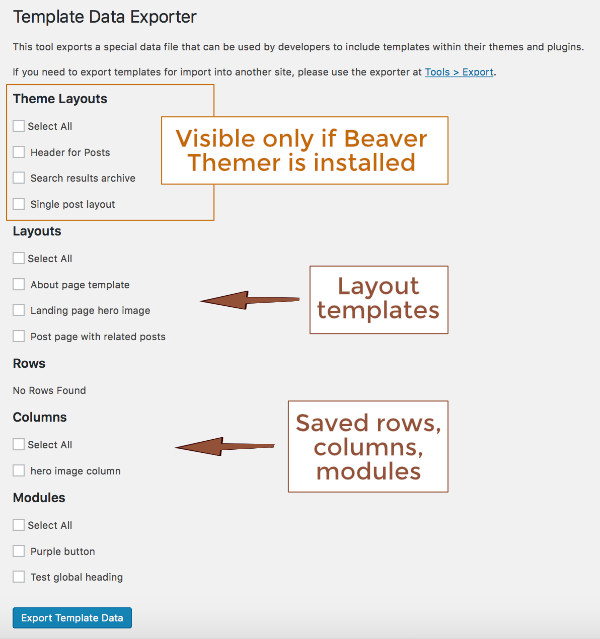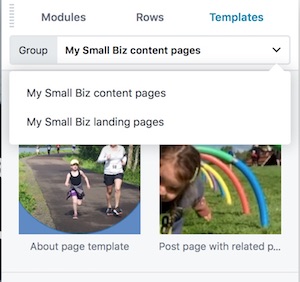Theme author templates
Theme authors can make their layout templates available to users within the lite and premium versions of Beaver Builder without needing to import them through the WordPress importer. This is perfect for theme authors who distribute Beaver Builder using TGM plugin activation, and it's a great addition for those already building custom modules for their themes.

Using the following method, templates are automatically made available in Beaver Builder’s template selector after you register them.
1. Decide where your templates will live
We recommend that you keep a copy of your templates on a source site for a better user experience. When a user selects a template for use, the media files in the template (such as images and videos) are not imported to their WordPress site but rather are linked to your source site. This is because users often don't want to import sample images that they will not be using.
For example, all of our templates live on a multisite instance at demos.wpbeaverbuilder.com. We also use this location for demos on our own website.
If you don’t keep a copy of your templates on the source site, users can still use your templates, but the media will not be loaded.
Templates are exported to .dat files, which must be transferred to source repositories as binary not ascii.
2. Create your layout templates
Create your custom layout templates and saved rows or modules for users.
3. Categorize and add featured images to the layout templates
Use the Beaver Builder admin panel (on the WordPress admin panel menu) assign categories and add featured images to your saved layout templates. See how to categorize and add thumbnails to saved layout templates. (This won't work for saved rows and modules.)
4. Export your template data file
In the WordPress admin panel, click Tools > Template exporter.
If you don't see that menu option, enable it by doing the following:- Go to Settings > Beaver Builder > User Access.
- In the Admin section, select the user roles that you want to have access to the Template Data Exporter
- Save the settings.
You’ll see a screen similar to the screenshot below.

- Select all templates or the specific layout templates, rows, and modules you want to export and click Export template data. A templates.dat file will download to your computer.
5. Register your templates
Register the templates.dat file with Beaver Builder, using the
FLBuilder::register_templates method within either a theme or plugin, as
shown in the example below.
The biggest consideration in deciding whether to register within the theme or in a plugin is whether you want the templates to remain accessible when the user switches to a different theme. If the answer is yes, register in a plugin. If no, register within a theme. If you choose a plugin, you can download an example plugin to use as a model.
To register in your theme:
Pass the full path of your templates.dat file to the FLBuilder::register_templates method:
FLBuilder::register_templates( '/path/to/your/templates.dat' );
In order to make sure that your theme or plugin doesn’t throw any errors, hook
that method into the after_setup_theme action, and check to see if the
builder is installed and the current version supports registering templates,
as follows.
function my_plugin_load_bb_templates() {
if ( ! class_exists( 'FLBuilder' ) || ! method_exists( 'FLBuilder', 'register_templates' ) ) {
return;
}
FLBuilder::register_templates( '/path/to/your/templates.dat' );
}
add_action( 'after_setup_theme', 'my_plugin_load_bb_templates' );
The templates will be loaded the next time you open Beaver Builder for editing.
6. Install and test your plugin or theme
Make sure your plugin (or theme) is installed and active and then open a page for editing in Beaver Builder. If you got everything right, your templates should show up in one of three places based on whether they are layouts, rows, or modules.
Layouts will show up on the Templates tab in the Content panel within the categories you specified, or Uncategorized if none, and opening a category will display the featured images of the templates in a thumbnail grid. The categories and underlying grid layout for a single category are shown in the following screenshot.

Your rows and modules are displayed on the Saved tab in the Content panel.
Things to keep in mind
Here are a few things to keep in mind when building templates for Beaver Builder.
Templates can only be created in the premium versions
The ability to create, save, edit and export templates is currently only available in the premium versions of Beaver Builder. You will need at least the Standard subscription to export templates.dat files.
Not all modules are available in the Lite version of Beaver Builder
If you build templates for the Lite version, keep in mind that not all of the premium modules are available there. If users use a template with a module that is not supported in their version of Beaver Builder, the module will not be rendered.
For this reason, we recommend third-party theme authors create custom modules for their themes and templates if they need something that isn’t available in the lite version. See the custom module guide.
Global rows and modules are exported as standard templates
Global rows and modules are exported to templates.dat as standard (non- global) rows or modules.